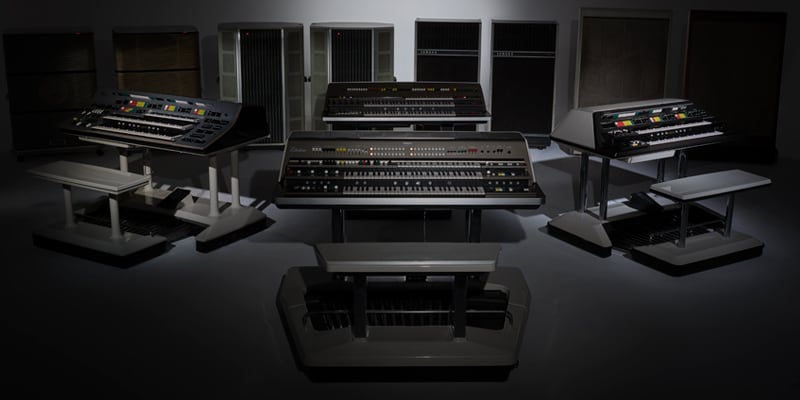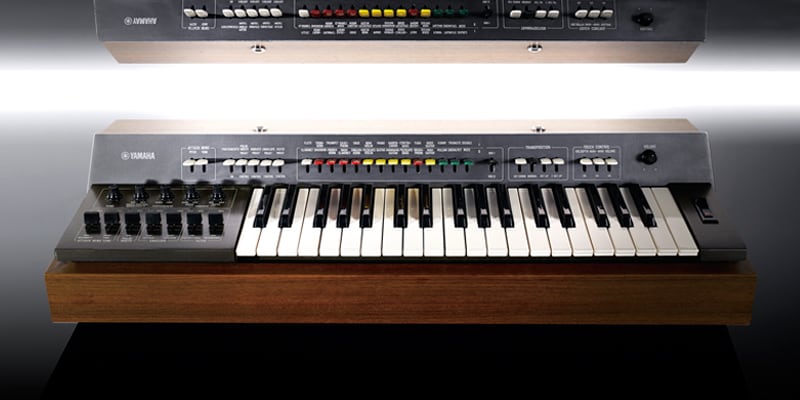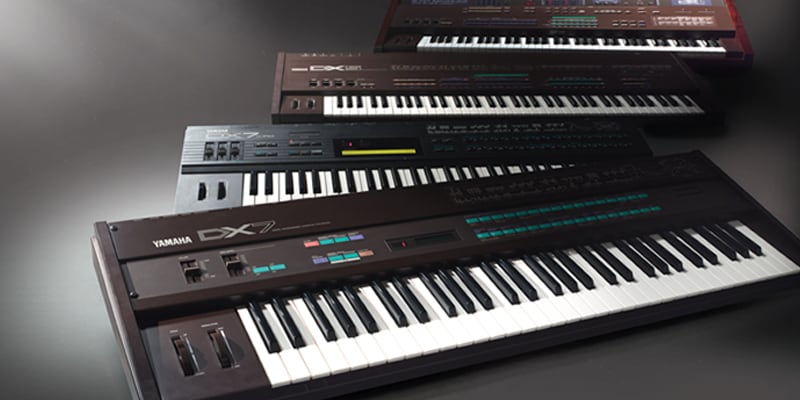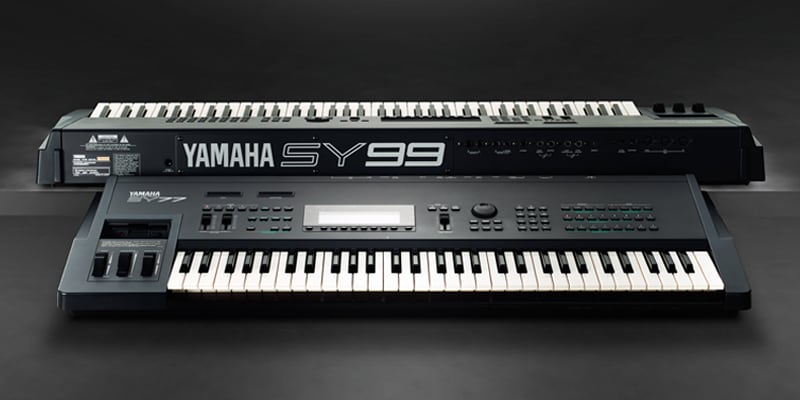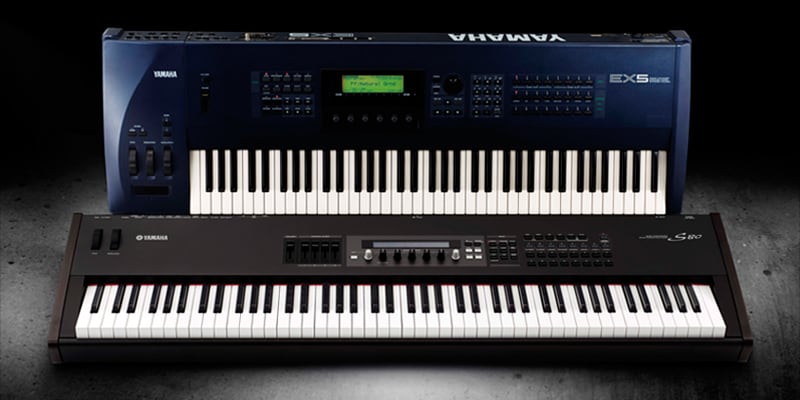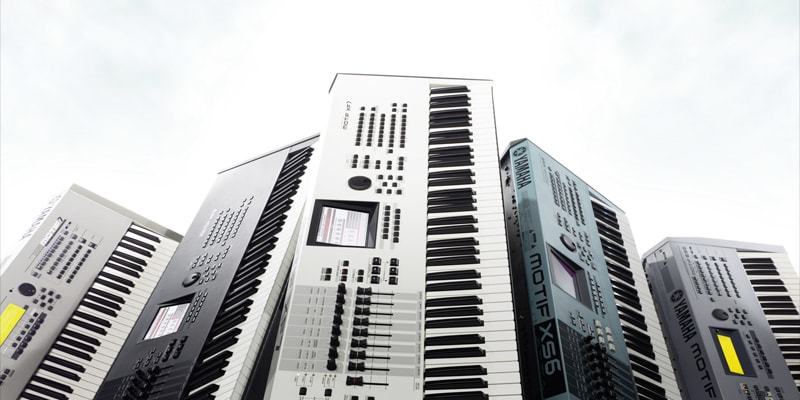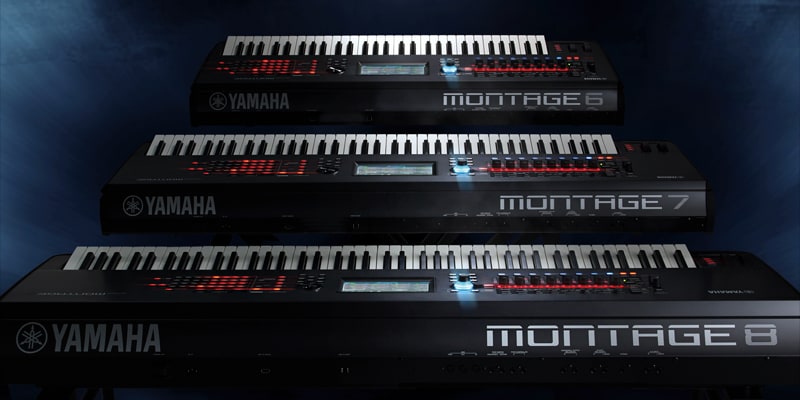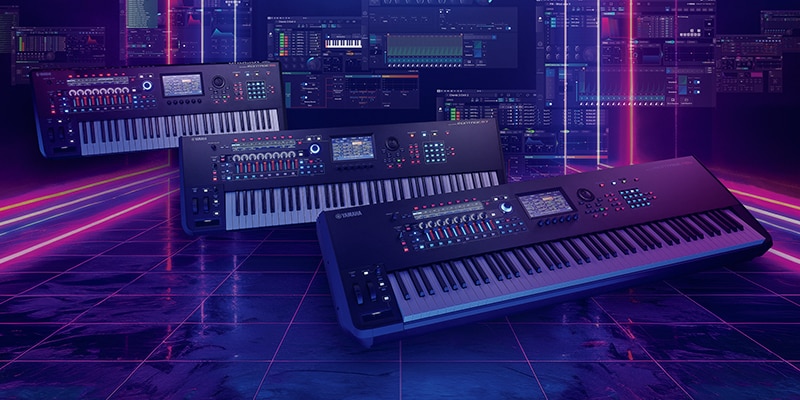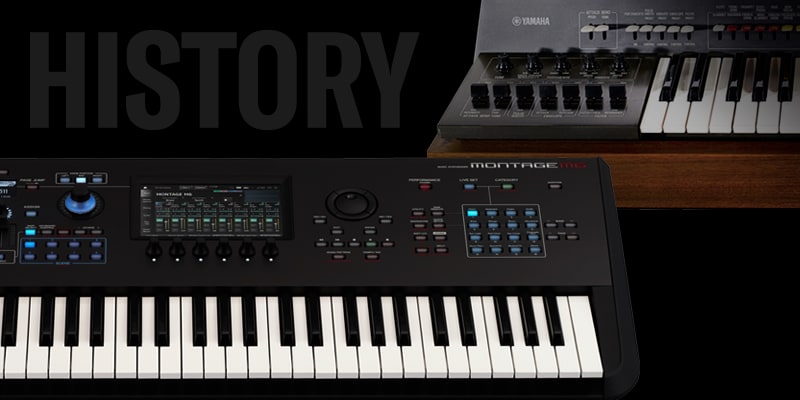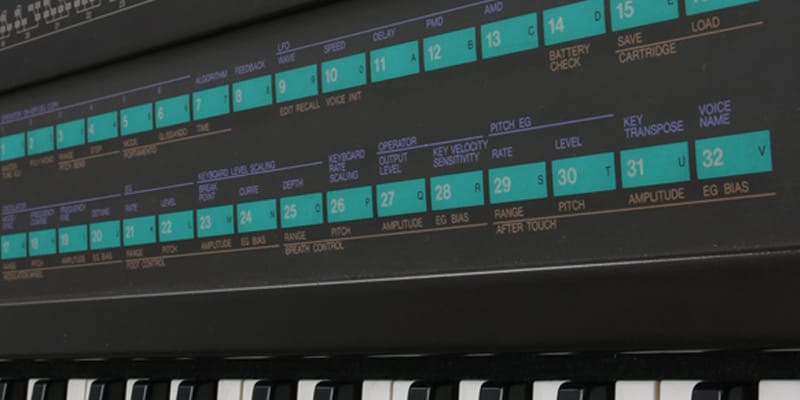Chapter 3: Evolution of Tone Generator Systems and Approaches to Music Production
Arrival of the Sampling-based Tone Generators

Spurred on by development of the FM tone generator, Yamaha transitioned its synthesizers to digital technologies during the 1980s. Thanks to advances in integrated circuits, we released products with a diverse array of new functions. One part of this approach involved the development of technologies that allowed digital recordings of the actual sounds of acoustic instruments—commonly referred to as "samples"—to be used as the tone generator. Drums, percussion, effect noises, and other similar sounds are relatively short, making them ideal for sampling; furthermore, very little adjustment of pitch or timbre is required when these recordings are played back. As such, sampling technology can be applied to easily recreate the sounds of these and other acoustic instruments. For this reason, various instrument manufacturers began to use sampling-based tone generation—also known as Pulse Code Modulation (PCM)—in drum machines and other similar products during the eighties. Here at Yamaha, we call this type of engine the Advanced Wave Memory (AWM) tone generator.
Yet this type of tone generator was not limited to drum sounds: it could also replay samples recorded from pianos, guitars, and other instruments with longer decay times, as well as the sustained sounds of organs and other keyboard instruments. That said, their main mode of use was as a sampler—that is, a device that replays recorded instrument sounds. At that time, they were not used in synthesizers to actually create sound. Many challenges still needed to be overcome before the Advanced Wave Memory (AWM) tone generator could effectively function as a synth engine, or as part of a highly expressive instrument for live performance.
One particularly difficult task was the development of digital filters that could behave in the same way as those featured in analog synthesizers. Although the mathematical formulas describing these devices were well understood at the time, their behavior in a digital circuit was far less smooth than that of an analog filter. Developers found it especially difficult to give character to "resonance," a highly distinctive feature of the analog synth. Other instrument manufacturers had already released synthesizers featuring digital filters, but the majority fell short. Many didn’t feature resonance at all, while others attempted to simulate this unique filter behavior in an artificial manner.
In 1989, Yamaha developed a digital filter capable of reproducing the behavior of an analog one. This filter made its long-awaited debut in our SY77 digital synthesizer. The SY77 was equipped with both an AWM tone generator and an FM tone generator, both of which could be used together with the digital filter to create remarkable levels of expression. These two new approaches to tone generation were named Advanced Wave Memory 2 (AWM2) synthesis and Advanced Frequency Modulation (AFM) synthesis, respectively. The SY77 made it possible to create exciting sounds using a hybrid-like combination of sampling and FM. It also harnessed many other groundbreaking functions—for example, the PCM waves of the AWM2 engine could be used as operator waves in the AFM tone generator. Additionally, the digital filter's cutoff frequency and resonance parameters could be controlled using the keyboard's velocity and aftertouch. The combination of all these features was referred to as the Realtime Convolution & Modulation (RCM) system. With its smooth digital filter and combination of both PCM and FM—the two giants of digital tone-generation of the time—the SY77 marked a landmark achievement, and went on to epitomize the advanced state of synthesizer technology of the 1990s.

Multitimbrality

Another key development in ‘90s synthesizers was the rise of multitimbral tone generators, which allow an instrument to play multiple sounds simultaneously—a crucial feature in music production. While less important for live keyboard performances, multitimbrality enables different instrument voices, like drums, bass, piano, and solos, to be played together. Its full potential was realized in the late ‘80s with the popularity of MIDI sequencers, allowing a single synthesizer to produce complete musical arrangements.
Amid this trend, multitimbral synths became increasingly popular for producing demo tapes and backing tracks for keyboardists. While multitimbral tone generators had existed since the earlier FM era, interest surged with the arrival of AWM2 and similar technologies, which offered high-quality, realistic acoustic instrument sounds. At the same time, fierce competition erupted between various synth makers as they strove to deliver products that were cheaper, yet had the capability to play more notes or voices simultaneously, and offered greater choice in voice variations.
Before then, playing multiple voices automatically with a MIDI sequencer required spending thousands of dollars to buy enough synthesizers for the required number of voices.
Now, a single instrument could effortlessly produce all these sounds simultaneously. Although various manufacturers addressed this need with tone generator modules supporting eight-part multitimbrality, our TG55 offered excellent value for money with a sixteen-part multitimbral sound system, as did the SY77 and SY55 workstations: revolutionary instruments that could be credited with vastly expanding the number of people producing music.
Evolution of Our PCM Synthesizers

As tone generators based on sampling technologies grew in popularity, synth makers introduced various types of instruments based on PCM tone generators, making the market increasingly competitive. Yamaha responded by further enhancing the AWM2 tone generator developed for the SY77 while exploring a range of other applications.
Released a year after the SY77 in 1990, our SY55 represented a significant technological advancement, by making it possible to simultaneously use four components known as "elements," each of which produced sound using sampled waves. This approach allowed sounds to be sculpted in a highly artistic and inventive fashion—for example, one could create an original voice by combining the attack portion of a piano with the sustained portion of a flute, or alternatively, assemble a horn-section sound from trumpet, trombone, alto sax, and tenor sax.
In parallel with these developments, thanks in part to the adoption of digital technologies, effects units were also evolving at a rapid pace. Synth owners could now process their sounds with the same high quality as dedicated hardware units found in professional recording studios by simply using the effects built into their instruments.
Introduced in 1991, the SY99 could sample external sounds for use in its AWM2 tone generator. With this and other features, the SY99 greatly enhanced expandability and sound creation capabilities, marking a major milestone for the PCM synthesizer. In fact, the AWM tone-generator design perfected in the first half of the nineties—together with "element" and other related terms—are used to this day in our MOTIF series.
Dawn of the Workstation Era

From the start of the nineties, the hardware sequencers that had been used in the latter half of the preceding decade—such as those of the QX Series—were gradually replaced by computer-based software sequencers. Meanwhile, in the recording studio, it became increasingly common to see a vast array of digital devices, such as MIDI interfaces connected to computers; samplers, synths, and other tone generators loaded into racks; as well as a master keyboard for entering performance data, all connected by a complex web of cables. Using this type of music production system with the computer at its core, a single musician could freely perform and record whatever tracks they wanted, and produce a complete song in a very short time. It was at around this time that the course of synthesizer development split into two different paths.
The first was predicated on the synth being used simply as a tone generator. While some tone generators were used with wind and guitar synths, the dominant trend was their integration into computer-based music production systems. However, the tone generator could be controlled by the computer or another MIDI signal source, meaning that it no longer had to be integrated with a keyboard as synthesizers of the past. To address this, Yamaha released a range of rack-mounted and desktop tone generators under the TG designation.
The second path developed the synth as a workstation capable of satisfying the requirements of both keyboardist and arranger—a format to which most of the keyboard-type synthesizers of the era adhered. Players could produce full-blown tunes using just the workstation, and, with no particular computer skills, make complete professional-level productions on a single instrument without any complicated cables. The previously mentioned SY99 brought all of these elements together, and was considered the ultimate ‘90s workstations. Furthermore, the SY series is now known as the genesis of the Yamaha workstation synthesizer.
The Quest for New Tone Generation Techniques

Starting in the early '90s, sampling and PCM tone generation became the foundation of synth sound production, centered on recording and playing back real instruments.
High-quality recording and playback make it possible to authentically replicate sounds. However, developing this into a convincing musical instrument was no easy feat, primarily because pitch and timbre had to be controlled in real time to make these sounds playable. Consider that a piano has 88 keys, MIDI represents playing strength on a 127-level scale, realistic sounds need to evolve and blend, and controllers must modulate sound for greater expression. With all these possibilities, multiple patterns accounting for each factor had to be recorded, and the most suitable one instantly selected for playback. This, in turn, called for huge volumes of recorded data to be processed by memory, yet processors remained slow and expensive. In this regard, the technologies of the day left much to be desired.
Although the Yamaha FM tone generation systems could produce highly expressive sounds without the need for much memory, our synthesizer development team embarked on a quest to identify new approaches that could create much more realistic sounds, like those of acoustic instruments. As a result, physical modeling was determined to be the most promising candidate.

Physical modeling is an approach to tone generation where the physical actions that occur when producing the sound are expressed in the form of mathematical equations. In turn, these equations are used to model the overall process. For example, let’s look at recreating the sound of a saxophone. This type of tone generator would mathematically model the musician blowing air into the instrument, the blown air causing the reed to vibrate, and the sound of the vibration being amplified due to sympathetic resonance inside the body of the sax. As with FM synthesis, this method is based on a theoretical approach developed at Stanford University, with fundamental research having started back in the ‘80s. However, it was not until the following decade—when the development of new tone-generation systems became an urgent matter—that the Yamaha synthesizer team began researching how to convert physical modeling into a practical technology for use in synths.
It took all the team's resources to achieve success, but their dedication ultimately paid dividends in the Virtual Acoustic (VA) tone generator—the first in the world to use physical modeling. We proudly unveiled this tone generator to the world in 1993 as the heart of the VL1 synthesizer. With just two-note polyphony, this unconventional synth contrasted starkly with the SY series and other similar instruments which possessed a much higher level of polyphony and were capable of simultaneously producing the sounds of multiple different instruments. With remarkable levels of realism, the VL1 was able to reproduce the sounds of wind instruments such as the saxophone and trumpet, as well as the violin and other string instruments. A signal from a sound generator, known as an “instrument,” was processed and shaped by a modifier, which controlled the sound of the instrument model. In the case of a woodwind, for example, an instrument corresponding to the mouthpiece or reed would be paired with a modifier that defined the material or shape of the model being simulated.

A range of parameters unique to the VL1 could be assigned to the instrument and modifier to modulate their behavior, but the real driver of this synth's authentic sound was the high degree of freedom with which it could be played. Unlike the synthesizers of the past, notes were not produced just by playing the keyboard: if modeling a wind instrument, for example, the VL1 could be set to produce sounds using its breath controller—a device that changes MIDI parameters based on how hard you blow onto it. With the VL1, the musician would blow onto the breath controller exactly as if he or she was blowing into the instrument being modeled, while at the same time pressing the keys on the keyboard.
To be fair, almost any MIDI-compatible synth of the day would have been able to control volume using a breath controller. What made the VL1 exceptional was the way in which it faithfully modeled instruments such as sax and trumpet, Even subtle changes in tone and pitch were produced based on how hard one blew onto the controller, all of which made for dramatically more realistic sounding performances. In fact, the wind instrument sounds produced by this synthesizer were often mistaken for the real thing, and its release attracted massive interest from all over the world. Subsequent models included the VL1-m, which had the VL1 as its tone generator module, and the low-cost VL70-m. Even today, these instruments are still being used by wind synthesizer musicians.

In addition to the Self Oscillation type VA (S/VA) tone generator used in the VL1, Yamaha also developed a Free Oscillation type—the F/VA. The VP1 virtual analog synthesizer, released the following year, was driven by this engine. The F/VA tone generator could model many different variations in the striking, plucking, and bowing of percussion and string instruments. However, rather than being limited to simulating existing sounds, it could also model instruments of the player’s own creation.
Although the VL1 and the VP1 synthesizers were technologically advanced and expressive, a number of different controllers, such as the breath controller, had to be played at the same time in order to perform on them. This meant that musicians needed to be highly skilled to play them. For this reason, they did not become particularly popular with conventional keyboard players and remained a niche instrument.
At the Mercy of the Nineties' Economy

In the 1980s, Yamaha established itself as a leader in the development of digital synthesizers with the groundbreaking DX Series. With the arrival of the PCM synth era in the latter half of that decade, we successfully developed the AWM2 tone generator, before moving on to the powerful SY Series. Yet all was not smooth sailing for this synth maker.
Back in the DX7 era, we proudly delivered high-performance synthesizers at reasonable prices to customers all over the world, but the rapid appreciation of the yen in the 90s severely eroded the price competitiveness of our products. In particular, the synthesizers that Yamaha had developed as entry level models priced higher overseas, putting them beyond the budget of the users for whom they were intended.

The collapse of the Japanese economic bubble brought further grief. The period from 1991 onward was marked by rapid economic decline in Japan, and sales of relatively expensive electronic instruments suffered greatly. Other Japanese manufacturers endured similar hardships and faced these difficult times by streamlining their product range, sharing functionality between multiple models, and reconfiguring their lineups with less expensive products.
Although the synthesizer had been born out of a desire to give musicians the same level of expression as acoustic instruments, advances in sampling technologies made it possible to produce the same sounds as these instruments with ease. As a result, more importance was placed on the synthesizer as an alternative to acoustic instruments than on creative sound design. Additionally, several other developments had made it easier to compare the sounds of synths from different manufacturers using the same performance data. For example, the General MIDI (GM) standard was published in 1991 for synthesizers that produced sounds in response to MIDI messages, and the Standard MIDI File (SMF) was developed as a common format for exchanging MIDI performance data. Consequently, synth buyers focused on the differences in sounds produced, as well as suitability to music production, than on functions and playability.

Taking their lead from this, other synth makers scaled back the development of hardware and functionality. Instead, they channeled their efforts into the quality and diversity of the waveforms at the heart of their PCM synthesizers. In other words, they strove to compete and differentiate themselves through digital content: a tactic that produced steady growth in customers.
In reaction to this trend of the times, Yamaha sought to get back on track via technological innovation, and worked to enhance the music production capabilities of our workstations. For the more cost-conscious customers, we released our W Series in 1994, followed a year later by the QS300 synthesizer—a model that supported the XG MIDI format. The W Series synths were particularly well suited to high-quality music production with their 8 MB of wave memory (the most available at the time), six independent effect processors, 16-part multitimbrality in all situations, and GM support. Unlike the instruments of the SY Series, however, these synths found little favor with pro keyboard players.

Numerous ideas, such as the development of new tone generators, adding innovative functionality, and further enhancing our PCM tone generators, were proposed to escape this rut. We also released a great many new products. Unfortunately, we were unable to keep up with rapid changes in the synthesizer market. We also failed to release any products that fully satisfied the needs of users. Needless to say, this exacerbated an already precarious situation for our synthesizers.
The Yamaha logo was slowly being replaced both on stage and in studio. We desperately needed a solution to overcome these challenges.



